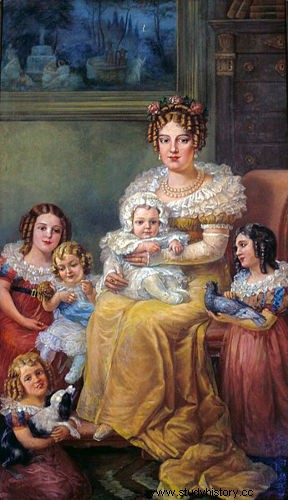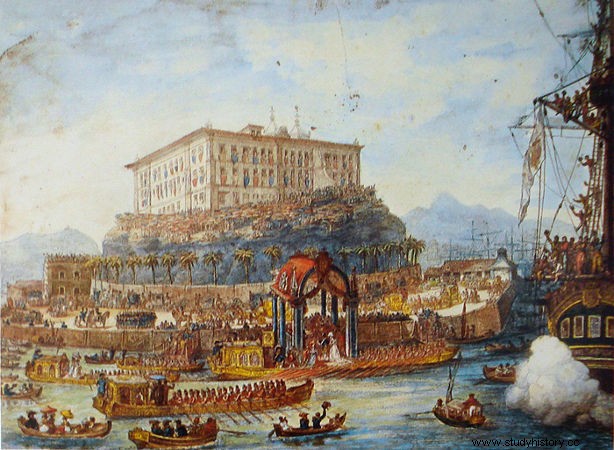Maria Leopoldina was an Austrian archduchess known for being the first empress of Brazil . Raised in one of the most traditional monarchies in Europe, Leopoldina married d. Pedro. She was marked by being one of the great influences for him to declare the independence of Brazil.
Leopoldina's marriage was not easy and she had an unhappy relationship. Her husband was extremely unfaithful to her, betraying her several times, even bringing his concubines to live with his wife. She gave birth to seven children and died at a young age, a victim of septicemia caused by a miscarriage.
Login also :Discover the main events that marked the First Reign
Birth and Youth

Leopoldina was born in Vienna and was a member of one of the most traditional European royal families:the Habsburg-Lorraine . She was born on January 22, 1797, to Empress Maria Theresa as her mother and Emperor Francis II (also known as Francis I of Austria) as her father. As a member of the Austrian royal family, her royal title was Archduchess.
Leopoldina was born in a tense time for the Holy Roman Empire (which became the Austrian Empire in 1806). Her country was at war with France, and absolutist monarchies in Europe were at risk because of the ideals of the French Revolution. Something that marked Maria Leopoldina's childhood was the fact that her great-aunt, Marie Antoinette, had been guillotined, years before her birth, as a result of the fall of the French monarchy.
The Austrian Archduchess's full name was Carolina Josefa Leopoldina Fernanda Francisca of Habsburg-Lorraine, and she had very white skin, blue eyes and blonde hair. The education by Leopoldina was complete and of excellent quality , as she was a member of the aristocracy. She learned to read and write, studied literature, history, music and dance, and spoke four languages (French, German, Italian and English).
she also learned rules of socializing that were part of royal life. Her maid was responsible for teaching her good manners and etiquette. Leopoldina's main interests were botany and mineralogy . An important part of her upbringing was being taught to blindly respect family decisions and putting the interests of the State and the monarchy always at the forefront .
Leopoldina's Wedding
Leopoldina's marriage to d. Peter it was the result of negotiations between the Austrian and Portuguese diplomatic corps initiated during the Congress of Vienna. In that context, Portugal sought to increase its importance and secure a position in the hall of great nations, and for that, a marriage with one of the most powerful monarchies in Europe would be useful.
The marriage of the heir to the Portuguese throne to an Austrian archduchess was important for the Portuguese, as it elevated them to one of the great European monarchies and, moreover, made them take a step for the reduction of English influence in Portugal. For Austrians, marriage opened up new possibilities for them in Brazil (recently promoted to the status of a kingdom).
The marriage between Leopoldina and d. Peter happened on May 13, 1817 , in a church located in Vienna. D. Pedro did not attend the ceremony due to the distance between Brazil and Austria, and therefore it was held by proxy . Who represented d. Pedro was Leopoldina's uncle:Carlos , the Duke of Tuschen .
It was only after the wedding that Leopoldina moved to Brazil. Her voyage lasted 85 days, and she arrived at the colony on November 5, 1817. Before that Leopoldina learned to speak Portuguese and prepared to come to the inhospitable country. Her father advised her not to be contaminated by the republican ideals that were popping up in America, according to historian Clóvis Bulcão | 1 |.
Along with Leopoldina came an Austrian diplomat and a group of scientists who would study botany in Rio de Janeiro. Her first impressions about Brazil and her husband were recorded by her in letters sent to her father and sister . In them the Austrian expressed her enchantment for the beauty of Rio de Janeiro and highlighted some points of the personality of d. Peter.
Login also :Understand if slavery could have been abolished in Brazil before 1888
Leopoldina's role in independence
Leopoldina played an important role in Brazil's independence, as she acted directly to convince d. Pedro to follow the path of rupture with Portugal. Historians point out that Leopoldina had a great political reading realizing that the political climate could lead the country to transform itself into a republic.
She understood that the only way to keep Brazil monarchical was to make d. Pedro remained in the country to lead the installation of a Bragança monarchy. As the historian Johanna Prantner defined it, Leopoldina “was certain that the liberation of Brazil from Portuguese tutelage could be negotiated in exchange for a constitutional monarchy supported by Brazilian patriots”|4| .
At the time she still enjoyed great influence with the Emperor and used it to get firmness in her decisions. D. Peter was undecided and took actions with great hesitation, and in this sense, Leopoldina acted to convince him that he should turn against Portugal.
Leopoldina was successful in her actions, and d. Pedro decided to stay in Brazil and lead to independence. The country, as she wished, became a monarchy. Finally, it is worth mentioning that it was she who presided over an emergency meeting that defined our independence — the letter sent after that meeting made d. Peter declared it on September 7, 1822.
Relationship with d. Peter

Leopoldina's relationship with d. Peter was, to say the least, troubled. According to her, d. Pedro was furious if things didn't go his way, and throughout the nine years of their marriage, the future emperor of Brazil never respected his wife. What most marked their relationship was the infidelity of the future emperor of Brazil.
D's first known extramarital affair. Pedro went with a French actress and dancer Noemi Thierry . D. Pedro got the Frenchwoman pregnant and was with her in Leopoldina's presence. It took the intervention of the King of Portugal to put an end to this relationship, and this was done when Naomi was sent to Recife. The son of Naomi and d. Pedro died before he was one year old.
Another famous extramarital affair by d. Pedro, and that was a great humiliation for Leopoldina, it was with Domitila de Castro , a woman he met during a trip to São Paulo. The involvement of d. Pedro with Domitila lasted for years, and she benefited greatly from him, acquiring goods, noble titles and directly helping her closest relatives.
After becoming Emperor of Brazil, d. Pedro I continued his relationship with Domitila for seven years. He got her pregnant, brought her to Rio de Janeiro and to live with his wife, the Empress of Brazil. With that Leopoldina felt progressively humiliated by the way d. Pedro treated her and for her attention to Domitila. Her mistress was transformed into the Marquise de Santos.
D. Peter called Domitila the “empress of my heart” | 2 |, and as time passed, he devoted increasingly worse treatment to his wife . The mistreatment of d. Pedro and Leopoldina began to be public, and even in front of his mistress he mistreated her, people of the time recorded how this happened.
D. Pedro started to block the funds spent on Leopoldina and on the maintenance of the house, and there are records that he assaulted her several times. Despite the unhappy marriage, the relationship of d. Pedro I and Leopoldina obtained what was expected of her:an heir to the Brazilian throne. That heir was d. Pedro II .
Login also :Find out about the reign of Maria Leopoldina's son
Death of Leopoldine
Leopoldina's last years were sad and marked by a progressive depression that hit her. This depression was caused by the humiliations she suffered from the emperor, mainly because of the affair with Domitila. There are several records that report the empress's state of mind, and we highlight one brought by the historian Isabel Lustosa:
I found Her Majesty in her library, all alone, and she appeared to be in poor health, and more depressed than usual. I left with a feeling of oppression, almost new to me, for I left her, as I foresaw, to a life of vexation greater than anything she had hitherto suffered, and in a state of health hardly conducive to bearing an additional burden. |3|.
In 1826 Leopoldina became pregnant again by the Emperor. The depression she suffered and the fights with her husband harmed her pregnancy. There are reports that she was even beaten in this state. Leopoldina had a miscarriage and, weakened, she died on December 11, 1826.
Notes
|1| BULCÃO, Clovis. Leopoldina, the Austrian who loved Brazil. In.:FIGUEIREDO, Luciano. History of Brazil for the busy . Rio de Janeiro:House of the Word, 2013. p. 237.
|2| LUSTOSA, Isabel. D. Pedro I :a hero with no character. São Paulo:Companhia das Letras, 2006.
|3| Ditto, note 2.
|4| PRANTNER, Johanna. Empress Leopoldina of Brazil . Petrópolis:Voices, 1997.
Image credit
[1] Commons
